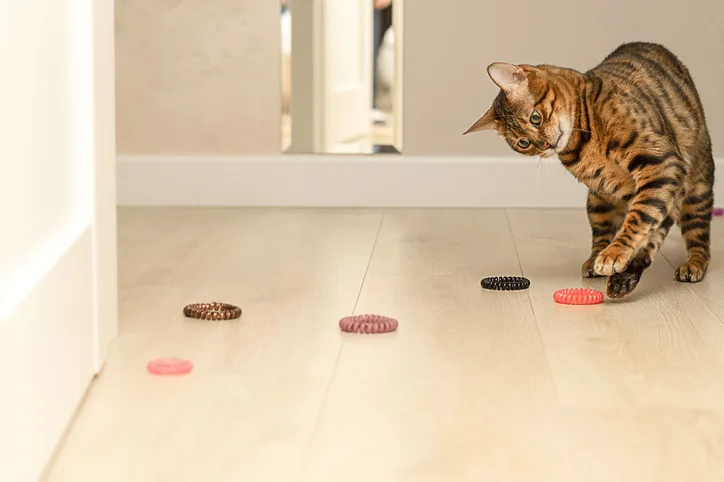
In the Literature
Fischer C, Chalifoux N, Reineke E. Emesis induction is successful for recovery of gastric foreign objects in cats. J Am Vet Med Assoc. 2023;261(9):1363-1367. doi:10.2460/javma.23.03.0176
The Research …
Emesis induction is commonly used in veterinary patients for decontamination or retrieval of ingested foreign objects1,2; however, there is minimal research on the success rate and factors associated with gastric foreign body object removal via emesis in cats.
This prospective study investigated the efficacy of emesis induction to retrieve gastric foreign material (eg, hair ties, rubber bands) in 22 cats. Although 14 cats vomited after emesis induction via dexmedetomidine or hydromorphone, retrieval was successful in only 11 cats. Of those, 8 cats vomited some or all of the material on initial emesis, and 3 cats vomited material on the second or third emetic event. More than 75% of foreign material was recovered in 7 of the 11 cats that experienced productive retrieval. In 3 cats in which the first attempt at emesis induction was unsuccessful, additional emetic agents were administered but were also unsuccessful, suggesting serial or layered administration may be ineffective. Although complications reported in this study were minimal (only sedation was noted), other adverse effects (eg, aspiration pneumonia, bradycardia, hypotension) are possible.3
Successful foreign object retrieval was not associated with time from object ingestion to emesis induction, time elapsed from last meal, type of foreign material ingested, type of emetic used, foreign object dimensions (eg, diameter, surface area), or patient signalment (ie, age, sex, breed, weight).
Stable cats with appropriate vital signs and a history of foreign material ingestion are ideal candidates for emesis induction. Emesis is contraindicated in cats that may have ingested sharp or corrosive material and should not be induced in cats already vomiting, cats with altered mentation, or cats with significant cardiac or respiratory disease. Special consideration should be given to brachycephalic cats due to potential increased risk for aspiration pneumonia. Endoscopy or surgery should be considered if emesis induction is significantly contraindicated or unsuccessful.
… The Takeaways
Key pearls to put into practice:
If indicated, recovery of gastric foreign objects via emesis in cats can be a clinically useful, minimally invasive technique.
Sedation is the most common adverse effect associated with administering dexmedetomidine or hydromorphone to induce emesis in cats.
In this study, emesis was successful in retrieving foreign material in only 50% of cats. Pet owners should be informed about the likelihood of success, and alternative methods for foreign material retrieval should be considered if emesis is unsuccessful.
Administering repeated doses or secondary emetics after failure to recover a foreign body may be ineffective; further studies are warranted.
You are reading 2-Minute Takeaways, a research summary resource presented by Clinician’s Brief. Clinician’s Brief does not conduct primary research.